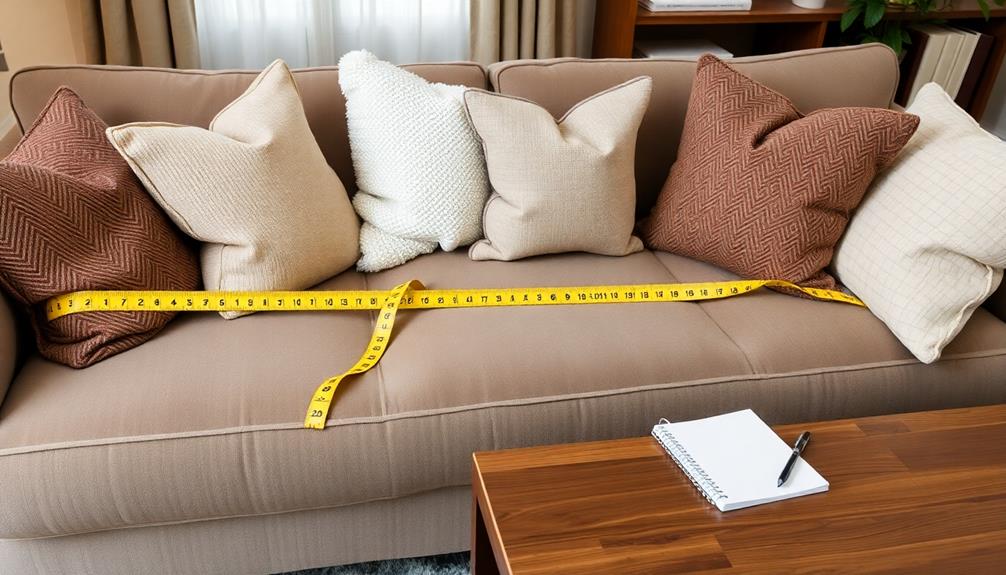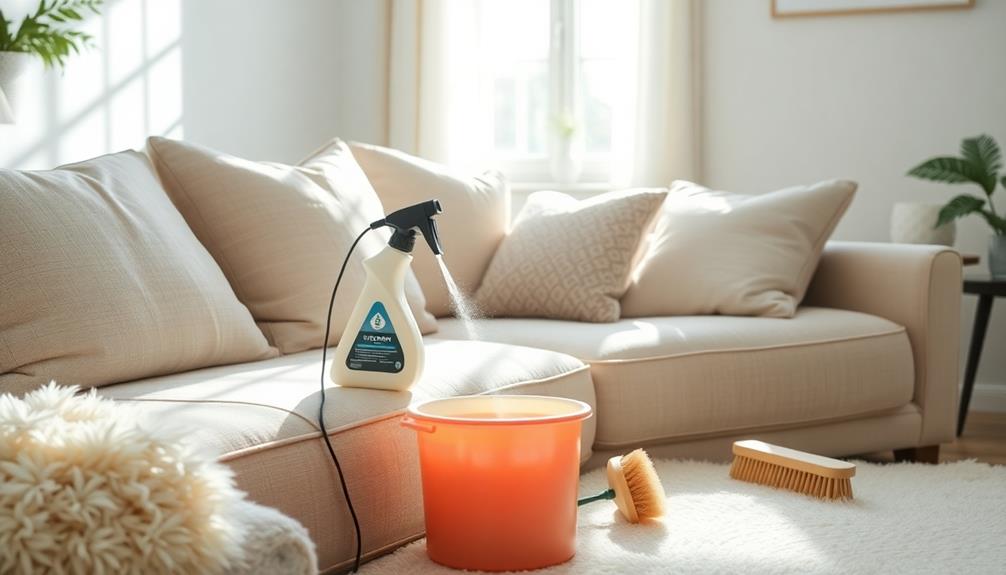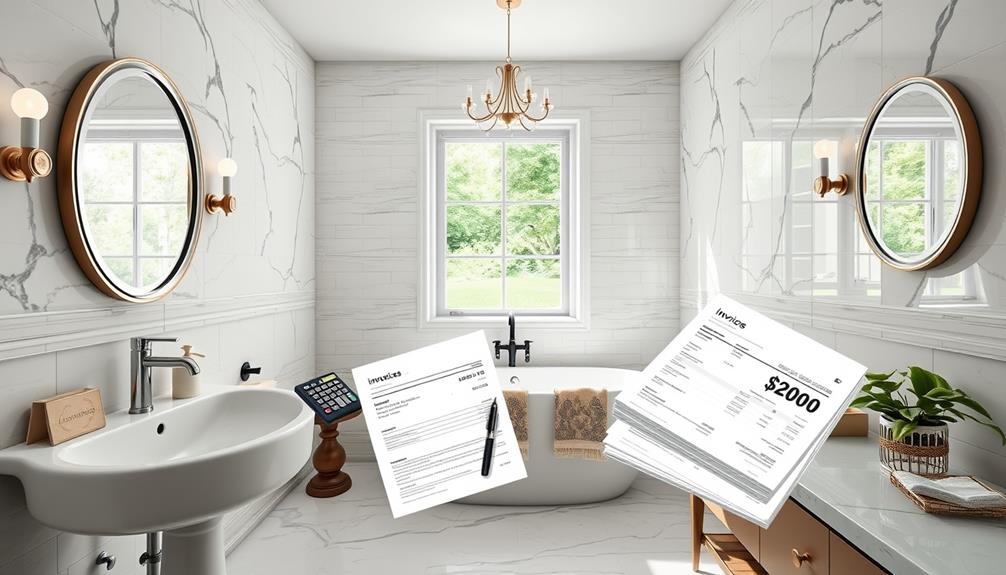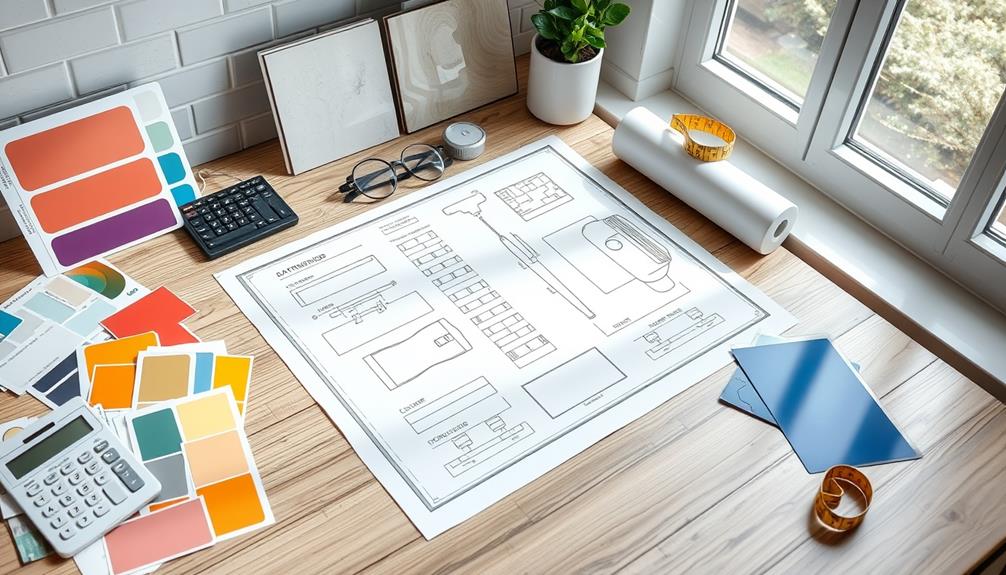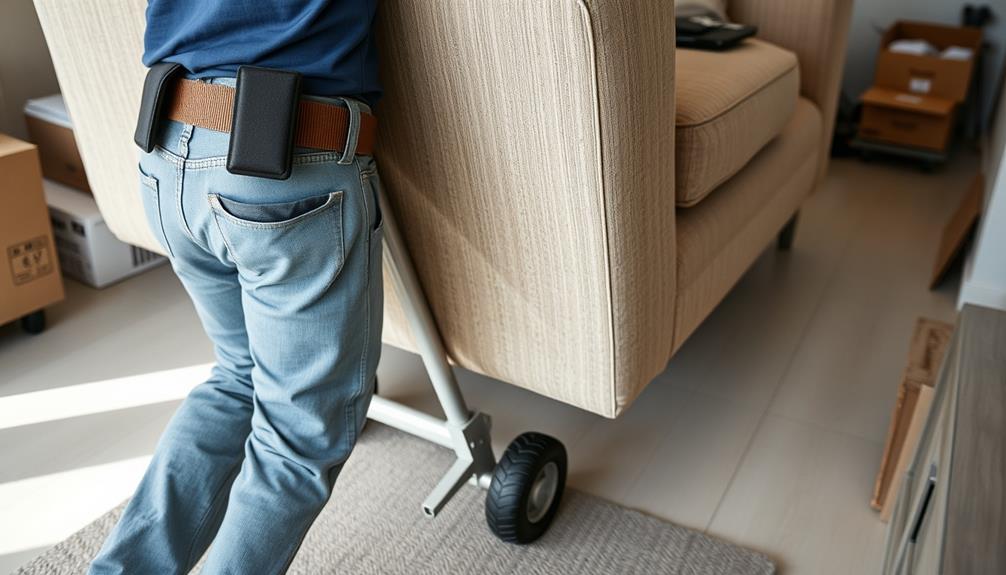To determine the size of a sofa, begin by verifying its width, height, and depth. Measure from the widest point of the arms for width, the tallest part for height, and from front to back, accounting for cushion overhang for depth. Be sure to also measure doorways and hallways, taking note of any potential obstacles like light fixtures and other furniture. Creating an outline with painter’s tape where the sofa will be placed can help you visualize the space. Always allow for extra inches to ensure easy delivery and a perfect fit in your room. Stay tuned for additional helpful tips on how to properly measure your sofa.
Key Takeaways
- Measure the width, height, and depth of the sofa, considering outside dimensions and seat measurements for accuracy.
- Check entryways, hallways, and any potential obstacles to ensure the sofa can be maneuvered into your space.
- Use painter's tape to outline the sofa's footprint in your room to visualize the placement and assess surrounding features.
- Conduct multiple measurements to minimize errors and ensure a proper fit within the designated space.
- Consider standard sofa dimensions to guide your selection based on your room size and design aesthetics.
Importance of Accurate Measurements
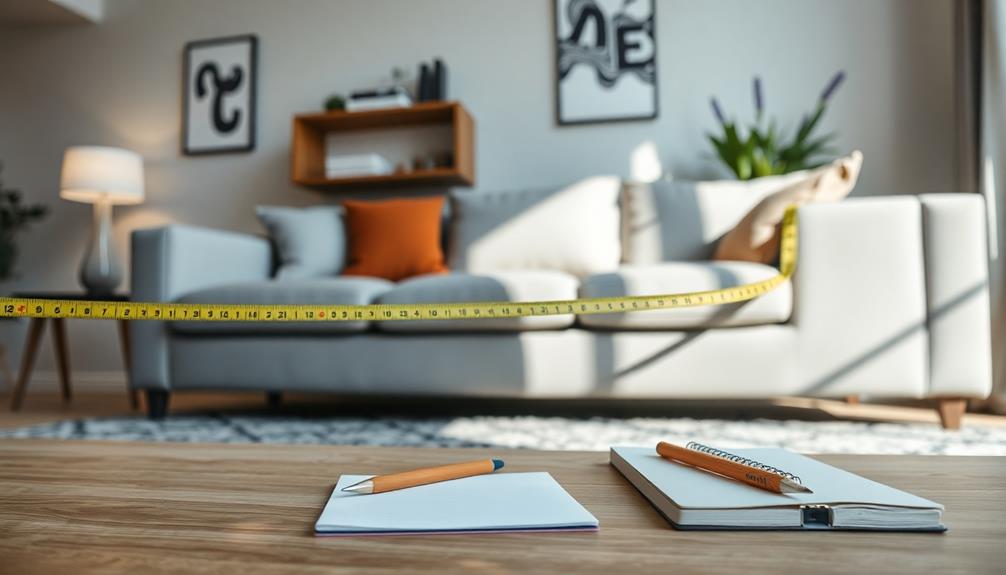
When measuring for a sofa, understanding the importance of accurate measurements can't be overstated. The right dimensions guarantee your new sofa fits perfectly through doors, hallways, and tight spaces, preventing delivery complications that could lead to frustration. You don't want to find out your dream sofa won't fit through your front door!
Additionally, just as a well-planned budget enhances your financial health, careful measurements enhance your space's layout and flow.
Taking precise measurements also saves you the hassle of returns due to size mismatches. Nobody wants to deal with the time and money lost from a sofa that doesn't fit. Accurate measurements assure that the sofa will be proportionate to your existing furniture, enhancing the overall aesthetics of your room.
Moreover, when you measure correctly, you can communicate effectively with designers and salespeople. They'll appreciate your attention to detail and be able to help you make informed purchasing decisions.
Finally, knowing the exact dimensions allows you to evaluate space for companion pieces, guaranteeing a harmonious room layout.
In short, accurate measurements are vital for guaranteeing your new sofa fits seamlessly into your home, both physically and aesthetically. So grab that tape measure, and let's get started!
Preparing Your Space
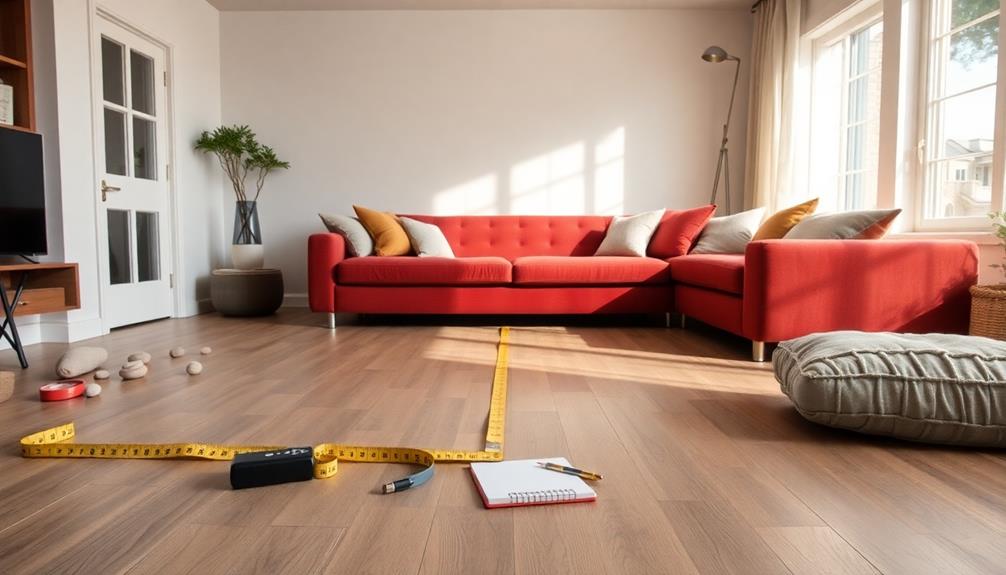
Before bringing your new sofa home, you need to measure entryways and hallway clearance carefully. Understanding your space's layout and dimensions is essential to guarantee that your sofa fits perfectly without any hassle.
Identify any potential obstacles that could hinder the sofa's movement into your space, such as light fixtures or existing furniture. This way, you'll guarantee a smooth shift and a perfect fit for your room.
Additionally, consider how appliance compatibility might affect your overall space, especially if you're incorporating other furniture or appliances.
Measure Entryways Carefully
Measuring your entryways carefully is vital to guarantee your new sofa fits seamlessly into your space. Start by measuring the width and height of all entryways, including door frames, to confirm the sofa can pass through without obstruction.
Pay special attention to any narrow points in hallways; these dimensions can greatly affect maneuverability during delivery. Additionally, considering the potential for financial considerations for elderly care can help you plan for any costs associated with moving furniture or making adjustments to your space.
Next, identify and measure around potential obstructions like radiators, shelves, or light fixtures that could impede the sofa's path. It's important to have a clear understanding of your space before the delivery.
When you measure entryways, always leave a few extra inches for maneuvering space to accommodate any awkward angles during delivery.
If your sofa needs to go upstairs, don't forget to measure the width, height, and diagonal clearance at the narrowest points, as these can present challenges when carrying the sofa.
Assess Hallway Clearance
Evaluating hallway clearance is essential for ensuring your sofa can be delivered without any hitches. Start by measuring the width of your hallways at their narrowest points. This will help you determine if the sofa can maneuver through without obstruction. Be sure to account for any items like radiators, shelves, or light fixtures that may reduce the effective clearance space. It's a good idea to leave a few extra inches of clearance when measuring, especially in tight spaces.
Next, check the height of doorways and any ceiling obstructions along the delivery path. You want to make sure the sofa can fit through without needing to be tilted or disassembled. Don't forget to take into account the angles of turns in the hallway; if a turn is required, measure the diagonal space to confirm the sofa can navigate the corner comfortably.
Here's a handy table to summarize your measurements:
| Measurement Type | Suggested Action |
|---|---|
| Width of Hallway | Measure at narrowest point |
| Height of Doorway | Measure height |
| Clearance for Turns | Measure diagonal space |
| Obstructions | Identify and note |
| Extra Clearance | Add a few inches |
Identify Potential Obstacles
Once you've assessed your hallway clearance, it's time to identify potential obstacles that could complicate the delivery of your new sofa.
Before you measure the space, take a thorough look at your entryway dimensions. Check for any obstructions that might limit your sofa's movement.
Here are some key points to take into account:
- Door Openings: Make sure they're wide enough for your sofa to fit through.
- Radiators and Shelves: These can create tight spots, so take their dimensions into account.
- Light Fixtures: Check the height and position to avoid any bumps.
- Staircases and Landings: Assess clearance, especially at their narrowest points.
Additionally, reflect on the layout of your home, as it may resemble the way homeowners evaluate home security systems to make a smooth entrance.
Don't forget to leave extra inches for maneuvering around corners and obstacles.
A handy trick is to use painter’s tape to outline where your sofa will go. This visual aid will help you spot any potential issues in the surrounding space. Once you have your sofa in place, you might want to add some decorative elements like pillows or a throw blanket. If you’re looking for sofa throw covering ideas, consider using a mix of textures and patterns to add some visual interest to your living space. Geometric prints, chunky knits, and faux fur are all popular choices for sofa throws that can add warmth and style to your seating area.
Measuring Techniques

When tackling the task of measuring a sofa, it's essential to start with the outside dimensions. You'll want to measure the width, height, and depth accurately. For width, measure from the outermost arms; for height, find the highest point of the back; and for depth, measure from the front to the back, including any cushion overhang. Incorporating elements like vintage and antique furnishings can enhance your sofa's fit within a modern farmhouse decor theme.
Next, pay attention to the inside measurements. Measure your room by checking the inside seat width between the arms, the inside back height from the seat cushion to the top of the back, and the inside seat depth from the back pillow to the front of the seat cushion.
To achieve accurate measurements, don't forget to measure the diagonal depth by extending your tape from the back frame to the front arm. Always double-check your measurements, as variations in cushion compression can affect the overall sofa dimensions.
Sofa Dimension Guidelines
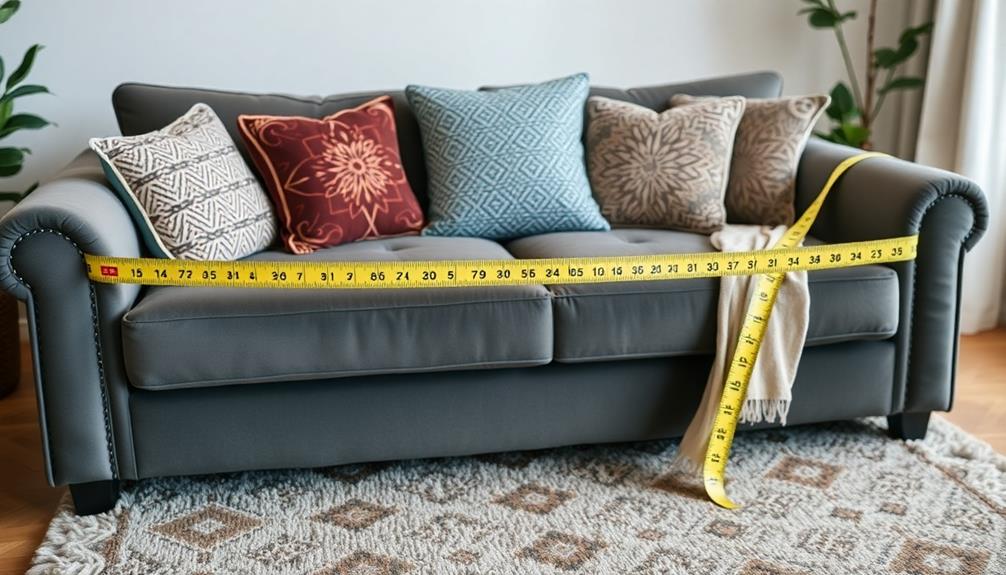
When choosing a sofa, knowing the standard dimensions is vital for fitting your space.
Understanding how a sofa fits within the overall design of a room can help create a cohesive look, making it essential to think about not just size but also the unique charm it brings to your interior.
You'll want to measure the width, height, and depth accurately to guarantee it meets your needs.
Let's break down these measurements and how they can guide your selection process.
Standard Sofa Dimensions
Understanding standard sofa dimensions is essential for selecting the right piece for your space. Knowing these dimensions helps you measure the width and guarantee your sofa fits comfortably in your room.
Here are some standard sofa types and their typical dimensions: Many hotels, like those featuring luxurious water parks, offer spacious seating options that can inspire your choices at home.
- 3-Seater Sofa: About 82 inches wide, 36 inches deep, and 32 inches high (ranges from 73 to 87 inches).
- Loveseat: Generally averages 64 inches wide, 36 inches deep, and 32 inches high (typically between 56 and 72 inches).
- Modular Sofa: Widths range from 20 to 35 inches, depths from 34 to 40 inches, and heights from 30 to 35 inches.
- L-Shaped Sofa: Total widths can vary from 90 to 150 inches, depths from 60 to 95 inches, and heights usually between 34 and 40 inches.
When you consider these dimensions of the sofa, you'll have a clearer idea of what works for your room.
Measuring Techniques Overview
Selecting the right sofa goes beyond just knowing standard dimensions; it's about how to measure your specific piece accurately.
Start by measuring the length. Do this by measuring from the outermost arms at the widest point. For standard three-seaters, this typically ranges from 73" to 87". Additionally, understanding your personal style and how it aligns with astrological signs and perceived beauty can enhance your confidence in making a choice.
Next, measure the height. You'll want to measure from the floor to the highest point of the back, which usually falls between 30" and 35".
For depth, measure from the front edge of the seat cushion to the back. Standard depth ranges from 34" to 40". Don't forget about the diagonal depth, which is vital if you're working with tight spaces; this is measured from the back frame to the front arm.
Precision is key, so check each measurement multiple times. Variations could lead to fitting issues in your intended space, so take your time.
Additional Measurement Tips
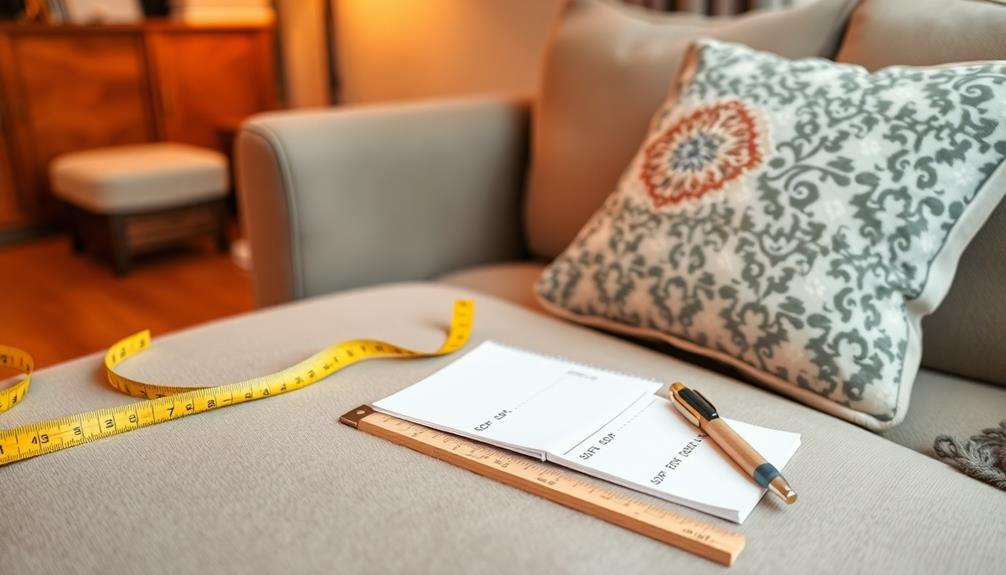
Accurate sofa measurements can save you from potential headaches down the line, so it's important to measure multiple times. Small errors can lead to fitting issues, especially with key dimensions.
Here are some additional measurement tips to help you measure a sofa effectively: Additionally, understanding the emphasis on collaboration with clients can enhance your approach to choosing the right sofa for your space.
- Use a flexible measuring tape: This tool allows you to navigate around curves and corners, ensuring precise measurements for sectional or curved designs.
- Account for detachable components: When measuring height, consider legs or cushions that might affect the overall height once the sofa's fully assembled.
- Include arm width and back height: These important measurements are crucial for ensuring the sofa fits well within your designated space and works with your other furniture.
- Measure diagonal depth: This will help you assess how the sofa will fit through doorways and hallways, revealing potential access challenges that standard measurements might overlook.
Ensuring Proper Fit
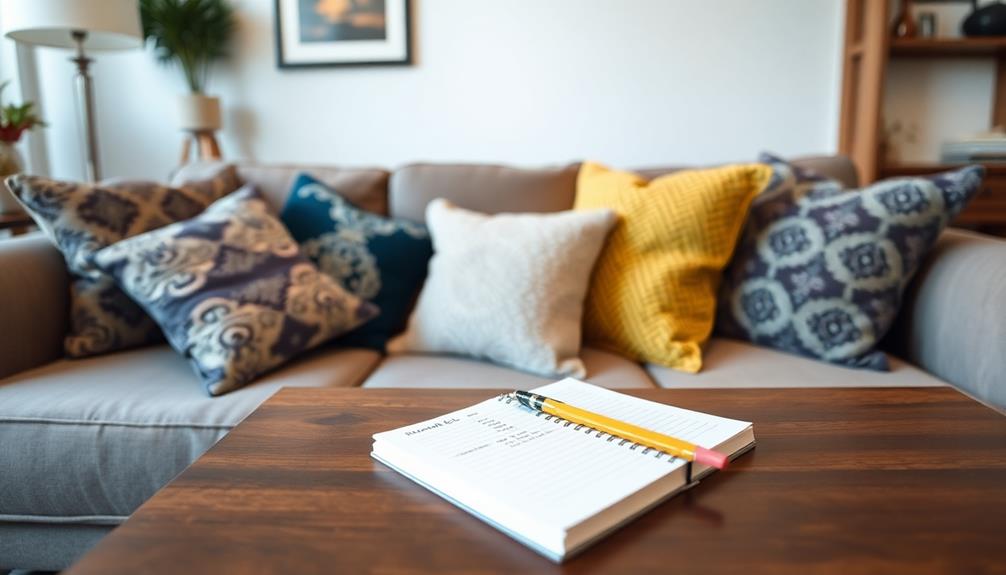
Finding the right fit for your sofa is vital to creating a harmonious living space. To guarantee a proper fit, start by measuring the sofa's length from the outermost arms. Make sure it doesn't exceed the available space in the room, ideally occupying about two-thirds of the room size for balance.
Consider how the sofa integrates with your overall design, such as designing the perfect alfresco living space that harmonizes with your outdoor areas. Don't forget to measure all entry points, including door widths and hallway dimensions, to confirm the sofa can be maneuvered through without any hassle during delivery.
Next, assess the height of the sofa, measuring from the floor to the highest point of the backrest. This ensures it fits comfortably under any ceiling or overhanging fixtures.
You'll also want to check the depth of the sofa by measuring from the front edge of the seat to the back, including any cushion overhang. This step is vital for maintaining adequate walking paths around other furniture.
Lastly, conduct multiple measurements of the sofa's dimensions and the intended space. This attention to detail will help avoid costly mistakes or returns due to size mismatches, guaranteeing your new sofa fits perfectly in the room.
Sofa Placement Considerations
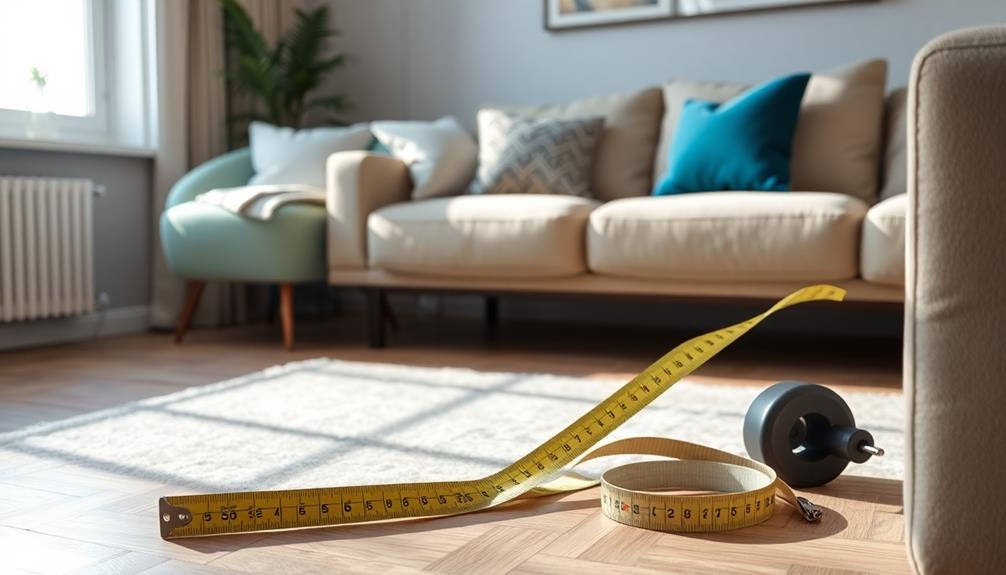
Creating a comfortable and inviting atmosphere in your living space begins with thoughtful sofa placement. To guarantee your sofa fits perfectly, you'll want to take into account a few key factors:
- Room Size: Aim for your sofa to occupy about 2/3 of the room size for a balanced look.
- Breathing Room: Leave at least 18 to 32 inches of space around the sofa. This facilitates movement and allows for the addition of side tables or coffee tables.
- Viewing Distance: Measure the width of your TV area; the ideal viewing distance should be 1.5 to 2.5 times the diagonal size of your screen for the best comfort.
- Layout Visualization: Use painter's tape to outline the sofa's footprint on the floor. This helps you visualize the placement and guarantees adequate space for walking around it.
Also, assess nearby features like doors, windows, and electrical outlets to avoid obstructions.
With these factors in mind, you can achieve a harmonious sofa placement that enhances your living space's functionality and style.
Frequently Asked Questions
What Is the Correct Way to Measure a Sofa?
To measure a sofa correctly, start by checking its width, height, and depth. Use a tape measure, guarantee accuracy, and consider diagonal depth for tight spaces. Double-check your measurements for the best fit.
What Is the Standard Size of Sofa?
When you think of standard sofas, imagine the comfort of a 3-seater at 82 inches wide. In contrast, a loveseat offers cozy intimacy at 64 inches. Each size fits different spaces and needs perfectly.
What Is the Rule of Thumb for Sofa Size?
When choosing sofa size, remember it should ideally occupy two-thirds of your room's length. Ascertain it complements your furniture and allows 18-32 inches for side or coffee tables for a balanced, comfortable space.
How to Measure a Sofa for a Throw?
When it comes to measuring a sofa for a throw, you've gotta measure width, depth, and height. Don't forget to add extra inches for that cozy, draped look you're after. Happy decorating!
Conclusion
Now that you've mastered the art of measuring a sofa, you're ready to transform your space into a cozy haven. Like a tailor crafting a suit, precision is key; every inch counts. With your careful measurements in hand, you'll dance through your living room, ensuring your new sofa fits like a glove. So go ahead, embrace the joy of creating a harmonious home, where comfort and style waltz together in perfect unity.
